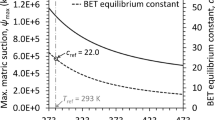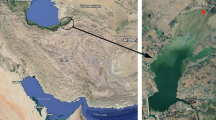Abstract
In this study, an experimental investigation into the effects of adding a limited proportion of silica sand and cement on crushing properties of simulated carbonate sand is presented. Silica sand in the proportion of 20, 30 and 50% and cement in the proportion of 2 and 4% by dry weight were the fractions added to the base soil. Cemented samples with different dry density 14 and 16 kN/m3 have been considered. Predictive models for the crushing parameter (Cr) are elaborated using the design of experiment method, considering silica sand fraction, cement fraction and effective normal stresses parameters. A good correlation between the values given by the experimental tests and those given by the model was observed. The main effects of the addition of silica sand and cement are reduction of particles crushing, leading to a soil exhibiting less contraction during shearing. Addition of a fraction of silica sand and/or cement enhances the resistance of the particles to crushing occurring during shear. The greatest resistance in crushing is produced when both a fraction of cement and silica sand are added to the soil and mixed at a denser state.






Similar content being viewed by others
References
Allman MA, Poulos HG (1988) Stress-strain behaviour of an artificially cemented calcareous soil. In: Proc 1st Int conf on calcareous sediments, Perth, Australia, vol 1, pp 51–60
Airey DW, Randolph MF, Hyden AM (1988) The strength and stiffness of two calcareous sands. In: Proc 1st Int Conf on calcareous sediments, Perth, Australia, vol 1, pp 43–50
Attar A, Connolly R (2000) Evaluation thermo-mécanique d’un moule en béton très haute performance pour le procédé d’injection. Algerian J Technol 14(1):04–10
Bell FG (1993) Engineering treatment of soils. E & FN Spon, London
Breysse D, Attar A, Soulier B, Mesureur B (1997) Modelling of steel fiber reinforced concrete response in tension. Mater Struct 30:259–268. doi:10.1007/BF02486350
Carter JP, Airey DW, Fahey M (2000) A review of laboratory testing of calcareous soils. In: The second international conference on engineering for calcareous sediments, Manama, Bahrain, vol 1. A.A. Balkema, Rotterdam, pp 401–430
Coop MR (1990) The mechanics of uncemented carbonate sands. Geotechnique 40(4):607–626
Coop MR, Atkinson JH (1993) Mechanics of cemented carbonate sands. Geotechnique 43(1):53–67
Coop MR (2000) The influence of in-situ state on the behaviour of carbonate sands. In: The second international conference on engineering for calcareous sediments, Manama, Bahrain, vol 1. A.A. Balkema, Rotterdam, pp 379–399
Denis A, Attar A, Breysse D, Chauvin JJ (2002) Effect of coarse aggregate on the workability of sandcrete. Cement Concr Res 32:701–706. doi:10.1016/S0008-8846(01)00746-3
Fookes PG (1988) The geology of carbonate soils and rocks and their engineering characterisation and description. In: Proc int conf calcareous sediments, Perth, Western Australia, ISSMFE, vol 2, pp 787–805
Glendinning S, Grine K, Clarke BG (2003) Stabilisation of a weakly cemented carbonate soil of high void ratio. In: Vanicck et al. (eds) Proc XIII ECSMGE, CGtS, Prague, vol 1, ISBN 80-86769-00-3, pp 685–690
Golightly CR, Hyde AFL (1988) Some fundamental properties of carbonate sands. In: Proc 1st int conf on calcareous sediments, Perth, Australia, vol 1, pp 69–78
Grine K (2002) An investigation of the stability of carbonate sand. PhD Thesis, Civil Engineering Department, University of Newcastle upon-Tyne, UK
Grine K, Glendinnig S (2007) Creation of an artificial carbonates sand. Geotech Geol Eng J 25(4):441–448. doi:10.1007/s10706-007-9121-z
Goupy J (1988) La méthode des plans d’expériences. Editions DUNOD, Paris
Hull TS, Poulos HG, Al-Hossein H (1988) The static behaviour of various calcareous sediments. In: Proc 1st int conf on calcareous sediments, Perth, Australia, vol 1, pp 87–96
Joseph G, Ramamurthy K (2009) Workability and strength behaviour of concrete with col-bonded fly ash aggregate. Mater Struct 42:151–160
Murff JD (1987) Pile capacity in calcareous sands: state of the art report. In: Proc ASCE Journal of Geotechnical Engineering, vol 113(GT5), pp 490–507
Noorany I (1989) Classification of marine sediments. J Geotech Eng 1(115):23–37. doi:10.1061/(ASCE)0733-9410(1989)115:1(23)
Poulos HG, Lee CY (1988) Model tests on grouted piles in calcareous sediments. In: Proc int conf calcareous sediments, Perth, Western Australia, ISSMFE, vol 1, pp 225–260
Randolph MF, Erbrich C (2000) Design of shallow foundations for calcareous sediments. In: The second international conference on engineering for calcareous sediments, Manama, Bahrain, vol 1. A.A. Balkema, Rotherdam, pp 361–377
Semple R (1988) State of the art report on engineering properties of carbonate soils. In: Proc int conf calcareous sediments, Perth, vol 2, pp 807–836
Sherwod PT (1993) Soil stabilisation with cement and lime. Transport Research Laboratory, Berkshire
Taguchi G (1987) System of experimental design. Unipub/ Krans International Publication, New York, 224 pp
Zaki AB, Fouad MG, Khan AM (1991) Model pile testing in calcareous sediment of Red Sea. Can Geotech J 28:423–433. doi:10.1139/t91-052
Author information
Authors and Affiliations
Corresponding author
Rights and permissions
About this article
Cite this article
Grine, K., Attar, A., Aoubed, A. et al. Using the design of experiment to model the effect of silica sand and cement on crushing properties of carbonate sand. Mater Struct 44, 195–203 (2011). https://doi.org/10.1617/s11527-010-9619-3
Received:
Accepted:
Published:
Issue Date:
DOI: https://doi.org/10.1617/s11527-010-9619-3




